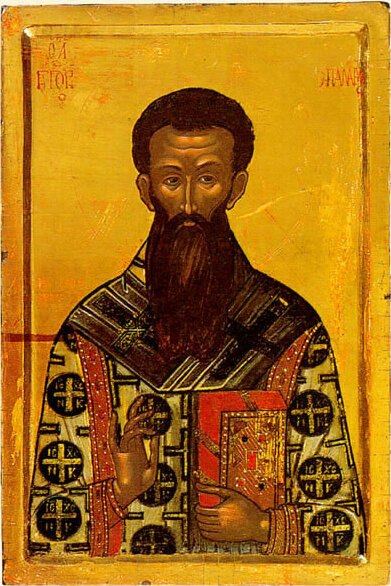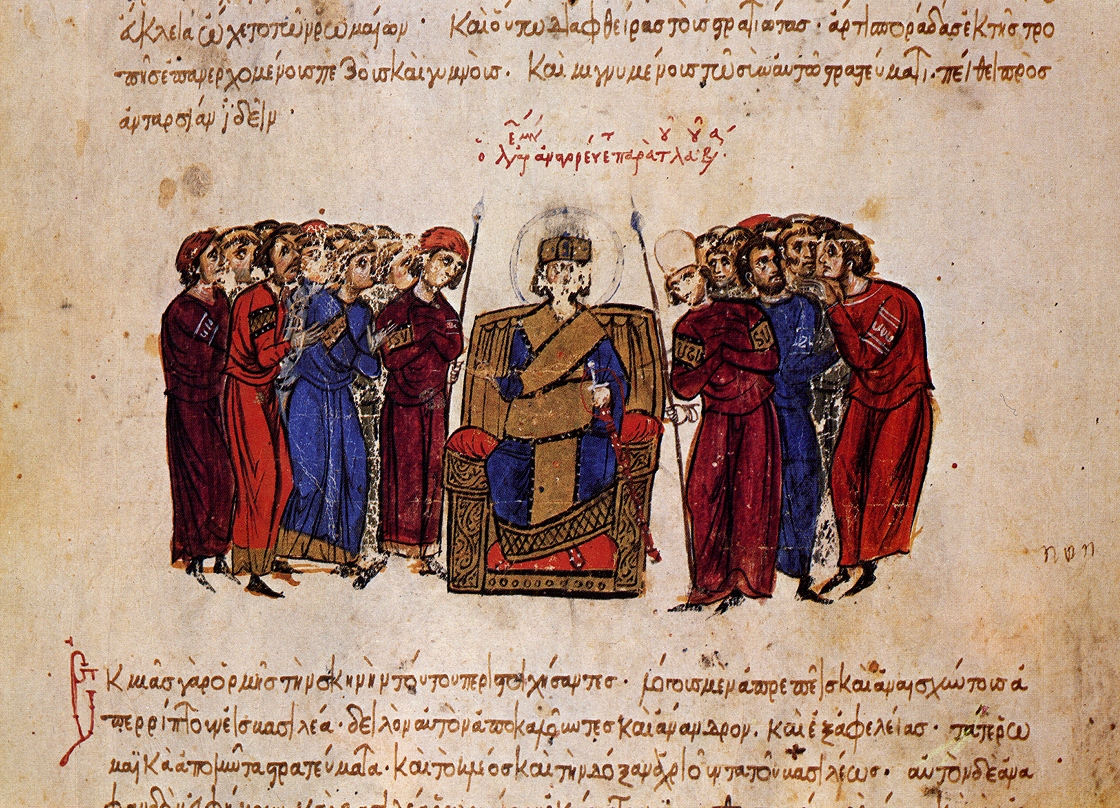|
Resident Synod
In the Eastern Orthodox Church, the endemic synod or ( gr, ἐνδημοῦσα σύνοδος) was the permanent standing synod of bishops of the Patriarchate of Constantinople that met frequently but irregularly to deal with issues of discipline and dogma. It was convoked and presided over by the patriarch. The term was first used to refer to the Council of Constantinople of 448, but the custom of convoking all bishops visiting or living in or near Constantinople to a synod as needed was already common when it was formalized by the Council of Chalcedon on 451. By the 9th century, the variable structure of the endemic synod had begun to crystallize. Only metropolitan bishops, autocephalous archbishops and the administrative functionaries of the patriarch (of which there were five) were permitted to attend meetings. The synod gathered after the death of a patriarch and proposed three names to the emperor to fill the vacancy, although the emperor was not bound by these. It also ... [...More Info...] [...Related Items...] OR: [Wikipedia] [Google] [Baidu] |
Eastern Orthodox Church
The Eastern Orthodox Church, also called the Orthodox Church, is the second-largest Christian church, with approximately 220 million baptized members. It operates as a communion of autocephalous churches, each governed by its bishops via local synods. The church has no central doctrinal or governmental authority analogous to the head of the Roman Catholic Church—the Pope—but the Ecumenical Patriarch of Constantinople is recognized by them as '' primus inter pares'' ("first among equals"), which may be explained as a representative of the church. As one of the oldest surviving religious institutions in the world, the Eastern Orthodox Church has played a prominent role in the history and culture of Eastern and Southeastern Europe. The Eastern Orthodox Church officially calls itself the Orthodox Catholic Church. Eastern Orthodox theology is based on holy tradition, which incorporates the dogmatic decrees of the seven ecumenical councils, the Scriptures, and the tea ... [...More Info...] [...Related Items...] OR: [Wikipedia] [Google] [Baidu] |
Nikephoros I Of Constantinople
Nikephoros I or Nicephorus I (c. 758 – 5 April 828) was a Byzantine writer and patriarch of Constantinople from 12 April 806 to 13 March 815. Life He was born in Constantinople as the son of Theodore and Eudokia, of a strictly Orthodox family, which had suffered from the earlier Iconoclasm. His father Theodore, one of the secretaries of Emperor Constantine V, had been scourged and banished to Nicaea for his zealous support of Iconodules, and the son inherited the religious convictions of the father. Nevertheless, he entered the service of the Empire, became cabinet secretary (''asekretis''), and under Irene took part in the synod of 787 as imperial commissioner. He then withdrew to one of the cloisters that he had founded on the eastern shore of the Bosporus, until he was appointed director of the largest home for the destitute in Constantinople c. 802. After the death of the Patriarch Tarasios of Constantinople, although still a layman, he was chosen patriarch by the wis ... [...More Info...] [...Related Items...] OR: [Wikipedia] [Google] [Baidu] |
Byzantine Empire
The Byzantine Empire, also referred to as the Eastern Roman Empire or Byzantium, was the continuation of the Roman Empire primarily in its eastern provinces during Late Antiquity and the Middle Ages, when its capital city was Constantinople. It survived the fragmentation and fall of the Western Roman Empire in the 5th century AD and continued to exist for an additional thousand years until the fall of Constantinople to the Ottoman Empire in 1453. During most of its existence, the empire remained the most powerful economic, cultural, and military force in Europe. The terms "Byzantine Empire" and "Eastern Roman Empire" were coined after the end of the realm; its citizens continued to refer to their empire as the Roman Empire, and to themselves as Romans—a term which Greeks continued to use for themselves into Ottoman times. Although the Roman state continued and its traditions were maintained, modern historians prefer to differentiate the Byzantine Empire from Ancient Rome a ... [...More Info...] [...Related Items...] OR: [Wikipedia] [Google] [Baidu] |
Palamism
Palamism or the Palamite theology comprises the teachings of Gregory Palamas (c. 1296–1359), whose writings defended the Eastern Orthodox practice of Hesychasm against the attack of Barlaam. Followers of Palamas are sometimes referred to as Palamites. Seeking to defend the assertion that humans can become like God through deification without compromising God's transcendence, Palamas distinguished between God's inaccessible essence and the energies through which he becomes known and enables others to share his divine life. Gerald O'Collins, Edward G. Farrugia. ''A Concise Dictionary of Theology'' (Paulist Press 2000) p186/260 The central idea of the Palamite theology is a distinction between the divine essence and the divine energies that is not a merely conceptual distinction. Palamism is a central element of Eastern Orthodox theology, being made into dogma in the Eastern Orthodox Church by the Hesychast councils. Palamism has been described as representing "the deepes ... [...More Info...] [...Related Items...] OR: [Wikipedia] [Google] [Baidu] |
Palaiologan Emperors
The Byzantine Empire was ruled by the Palaiologos dynasty in the period between 1261 and 1453, from the restoration of Byzantine rule to Constantinople by the usurper Michael VIII Palaiologos following its recapture from the Latin Empire, founded after the Fourth Crusade (1204), up to the Fall of Constantinople to the Ottoman Empire. Together with the preceding Nicaean Empire and the contemporary ''Frankokratia'', this period is known as the late Byzantine Empire. From the start, the regime faced numerous problems.Mango, p. 255 The Turks of Asia Minor had begun conducting raids and expanding into Byzantine territory in Asia Minor by 1263, just two years after the enthronment of the first Palaiologos emperor Michael VIII. Anatolia, which had formed the very heart of the shrinking empire, was systematically lost to numerous Turkic '' ghazis'', whose raids evolved into conquering expeditions inspired by Islamic zeal, the prospect of economic gain, and the desire to seek refuge from ... [...More Info...] [...Related Items...] OR: [Wikipedia] [Google] [Baidu] |
John Italos
John Italus or Italos ( el, , ''Iōánnēs ho Italós''; la, Johannes Italus) was a neoplatonic Byzantine philosopher of the eleventh century. He was Calabrian in origin, his father being a soldier. He came to Constantinople, where he became a student of Michael Psellus in classical Greek philosophy. He succeeded Psellus in his position as head of the philosophical school. Subsequently, some of his tenets were found heretic in 1076-77 by Patriarch Cosmas I of Constantinople, and in 1082 he was personally condemned, having come into conflict with Emperor . Life John Italus was born in < ...[...More Info...] [...Related Items...] OR: [Wikipedia] [Google] [Baidu] |
East–West Schism
The East–West Schism (also known as the Great Schism or Schism of 1054) is the ongoing break of communion between the Roman Catholic and Eastern Orthodox churches since 1054. It is estimated that, immediately after the schism occurred, a slim majority of Christians worldwide were Eastern Christians comprised; most of the rest were Western Christians. The schism was the culmination of theological and political differences between Eastern and Western Christianity that had developed during the preceding centuries. A series of ecclesiastical differences and theological disputes between the Greek East and Latin West preceded the formal split that occurred in 1054. Prominent among these were the procession of the Holy Spirit ('' Filioque''), whether leavened or unleavened bread should be used in the Eucharist, the bishop of Rome's claim to universal jurisdiction, and the place of the See of Constantinople in relation to the pentarchy. In 1053, the first action was ta ... [...More Info...] [...Related Items...] OR: [Wikipedia] [Google] [Baidu] |
Michael Keroularios
Michael I Cerularius or Keroularios ( el, Μιχαήλ Α΄ Κηρουλάριος; 1000 – 21 January 1059 AD) was the Patriarch of Constantinople from 1043 to 1059 AD. His disputes with Pope Leo IX over church practices in the 11th century played a role in the events that led to the East-West Schism, Great Schism in 1054. Background Michael Cerularius was born in Constantinople around 1000 AD and joined the Church at a young age. Schism Michael quarreled with Pope Leo IX over church practices in which the Roman Church differed from Constantinople, particularly the use of unleavened bread in the Eucharist. Dissenting opinions were also exchanged over other theological and cultural issues, ranging from the issue of papal supremacy in the Church to the ''filioque'' clause and other disagreements between the patriarchates. In 1054, Pope Leo IX sent a letter to Michael, citing a large portion of the ''Donation of Constantine'' believing it genuine. :"The first pope who used ... [...More Info...] [...Related Items...] OR: [Wikipedia] [Google] [Baidu] |
Leo V The Armenian
Leo V the Armenian ( gr, Λέων ὁ ἐξ Ἀρμενίας, ''Leōn ho ex Armenias''; 775 – 25 December 820) was the Byzantine emperor from 813 to 820. A senior general, he forced his predecessor, Michael I Rangabe, to abdicate and assumed the throne. He ended the decade-long war with the Bulgars, and initiated the second period of Byzantine Iconoclasm. He was assassinated by supporters of Michael the Amorian, one of his most trusted generals, who succeeded him on the throne. Life Leo was the son of the patrician Bardas, who was of Armenian descent (according to Theophanes Continuatus, Leo was also of Assyrian that is Syrian descent). Leo served in 803 under the rebel general Bardanes Tourkos, whom he deserted in favor of Emperor Nikephoros I. The Emperor rewarded Leo with two palaces, but later exiled him for marrying the daughter of another rebel, the patrician Arsaber. On the other hand, a contemporary source says that one general Leo of the Armeniakon theme was punishe ... [...More Info...] [...Related Items...] OR: [Wikipedia] [Google] [Baidu] |
Holy Synod
In several of the autocephalous Eastern Orthodox churches and Eastern Catholic Churches, the patriarch or head bishop is elected by a group of bishops called the Holy Synod. For instance, the Holy Synod is a ruling body of the Georgian Orthodox Church. In Oriental Orthodoxy the Holy Synod is the highest authority in the church and it formulates the rules and regulations regarding matters of church organization, faith, and order of service. Early synods The principle of summoning a synod or council of ecclesiastical persons to discuss some grave question affecting the Church goes back to the very beginning of the Church's history. Since the day when the Apostles met at Jerusalem to settle whether Gentile converts were to keep the Old Law ( Acts 15:6–29), it had been the custom to call together such gatherings as occasion required. Bishops summoned synods of their clergy, metropolitans and patriarchs summoned their suffragans, and then since 325 there was a succession of thos ... [...More Info...] [...Related Items...] OR: [Wikipedia] [Google] [Baidu] |
Autocephaly
Autocephaly (; from el, αὐτοκεφαλία, meaning "property of being self-headed") is the status of a hierarchical Christian church whose head bishop does not report to any higher-ranking bishop. The term is primarily used in Eastern Orthodox and Oriental Orthodox churches. The status has been compared with that of the churches ( provinces) within the Anglican Communion. Overview of autocephaly In the first centuries of the history of the Christian church, the autocephalous status of a local church was promulgated by canons of the ecumenical councils. There developed the pentarchy, i.e., a model of ecclesiastical organization where the universal Church was governed by the primates (patriarchs) of the five major episcopal sees of the Roman Empire: Rome, Constantinople, Alexandria, Antioch, and Jerusalem. The independent (autocephalous) position of the Church of Cyprus by ancient custom was recognized against the claims of the Patriarch of Antioch, at the Council of Ephe ... [...More Info...] [...Related Items...] OR: [Wikipedia] [Google] [Baidu] |





